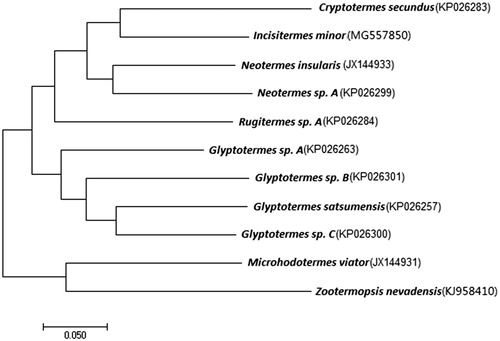Abstract
The complete mitochondrial genome of drywood termite, Incisitermes minor, is reported in this study. The circular mitogenome has a length of 15,970 bp and encodes 37 genes including 13 protein-coding genes (PCGs), 22 transfer RNA (tRNA), two ribosomal RNA (rRNA), and a non-coding control region (D-loop). The percentage of A and T (65.44%) within this mitogenome is much higher than that of G and C (34.56%). The phylogenetic tree revealed that mitogenomes of Kalotermitidae formed one clade. The tree also revealed that I. minor was closest to Cryptotermes secundus, and was a sister group to Neotermes. I. minor is a only species in which mitogenome has been completed so far among the Incisitermes termite. The data provide resource for ecological and evolution analysis within termites especially Kalotermitidae.
Incisitermes minor (Isoptera, Kalotermitidae) is an important economic pest and invasive species (Cabrera and Scheffrahn Citation2017). I. minor also causes economic loses in China. Incisitermes termites include I. minor and other species such as I. immigrans, I. incisus, I. marginipennis, I. synderi, and I. schwarzi (Krishna and Weesner Citation1970). Although there are studies on the 16s ribosomal RNA (rRNA) mitochondrial gene of I. minor (Austin et al. Citation2012), there is no available information about its complete mitochondrial genome. The present study was the first report on the complete mitochondrial genome sequences of I. minor and added to the greatly increased insect mitogenomes (Cameron Citation2014).
Specimens were collected from Liyang, Ninghai County, Ningbo City, China and stored in the Insect Lab at Zhejiang A&F University, China (accession number NB0022-NH-1). The entire mitochondrial genome sequence of I. minor was 15,970 bp in length, including 13 protein-coding genes (PCGs), 22 transfer RNA (tRNA) genes, two rRNA genes, and one non-coding control region (D-loop). The genetic compositions and coding sequences are similar to other termites (Chen et al. Citation2016; Meng et al. Citation2016; Herve and Brune Citation2017). The L-strand codes 14 genes including four PCGs (nad1, nad4, nad4L, and nad5), eight tRNA genes (trnQ, trnC, trnY, trnF, trnH, trnP, trnL1, and trnV), and two rRNA genes (rrnL and rrnS). The other 23 genes were coded by the H-strand.
The overall sequences in the mitochondrial genome of I. minor were A + T biased. The A + T content of I. minor was 65.44%, higher than that of G + C (34.56%). The mitochondrial genome of I. minor included intergenic spacers and overlapping regions. The intergenic spacer sequences were spread on 17 regions ranging in size from 1 to 22 bp, and the overlapping sequences varied from 1 to 8 bp in eight regions.
Thirteen PCGs have a total length of 11,156 bp. There were 22 tRNA genes in the mitochondrial genome of I. minor. In addition to the tRNA-Ser which lacked the dihydrorubamide (DHU) arm, the other tRNAs all have the classical clover leaf structures. rRNA gene, rrnL, rrnS, is 830 bp and 1311 bp in length, respectively. rrnS is located between trnV and the control region, whereas rrnL is located between trnL1 and trnV. The control region (D-loop) is located between rrnS and trnI gene, and is 1159 bp in length. The content of A + T in control region was 68.39%.
To understand the phylogenetic relationships among Kalotermitidae, a maximum likelihood phylogenetic tree was constructed using a dataset containing the nucleotide sequence of 13 PCGs of all mitochondrial genes (Bourguignon et al. Citation2015). Microhodotermes viator (Hodotermitidae) and Zootermopsis nevadensis (Archotermopsidae) were used as outgroups. On the tree, two major clades were formed, one clustering of M. viator, Z. nevadensis, and the other clustering of the remaining species which attach to the same family (Kalotermitidae) (). This result was similar to the topology obtained from previous molecular studies (Bourguignon et al. Citation2015). The phylogenetic tree revealed that I. minor was closest to Cryptotermes secundus, and was a sister group to Neotermes.
Figure 1. Maximum likelihood phylogenetic tree of selected termite mitogenomes including Kalotermitidae. The phylogenetic tree was built using 13 PCGs. Microhodotermes viator (Hodotermitidae) and Zootermopsis nevadensis (Archotermopsidae) were used as outgroups. Leaf names were presented as species names and GenBank accession numbers.

Nucleotide sequence accession number
The complete genome sequence of I. minor has been assigned GenBank accession number (MG557850).
Disclosure statement
The authors report that they have no conflicts of interest. The authors alone are responsible for the content and writing of the paper.
References
- Austin JW, Allen LS, Solorzano C, Magnus R, Scheffrahn RH. 2012. Mitochondrial DNA genetic diversity of the drywood termites Incisitermes minor and I. snyderi (Isoptera: Kalotermitidae). Florida Entomol. 95:75–81.
- Bourguignon T, Lo N, Cameron SL, Šobotník J, Hayashi Y, Shigenobu S, Watanabe D, Roisin Y, Miura T, Evans TA. 2015. The evolutionary history of termites as inferred from 66 mitochondrial genomes. Mol Biol Evol. 32:406–421.
- Cabrera BJ, Scheffrahn RH. 2017. Western drywood termite, Incisitermes minor (Hagen) (Insecta: Isoptera: Kalotermitidae). UF/IFAS Publication EENY248. http://edis.ifas.ufl.edu/in526.
- Cameron SL. 2014. Insect mitochondrial genomics: implications for evolution and phylogeny. Annu Rev Entomol. 59:95–117.
- Chen Q, Wang K, Tan YL, Xing LX. 2016. The complete mitochondrial genome of the subterranean termite, Reticulitermes chinensis Snyder (Isoptera: Rhinotermitidae). Mitochondrial DNA A. 27:1428–1429.
- Herve V, Brune A. 2017. The complete mitochondrial genomes of the higher termites Labiotermes labralis and Embiratermes neotenicus (Termitidae: Syntermitinae). Mitochondrial DNA B: Resour. 2:109–110.
- Krishna K, Weesner FM. 1970. Biology of termites. Vol. II. New York, London: Academic Press; p. 643.
- Meng ZY, Jiang SH, Chen XQ, Lei CL. 2016. The complete mitochondrial genome of fungus-growing termite, Macrotermes natalensis (Isoptera: Macrotermitinae). Mitochondrial DNA A. 27:1728–1729.
